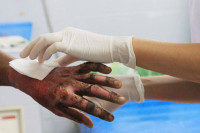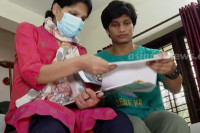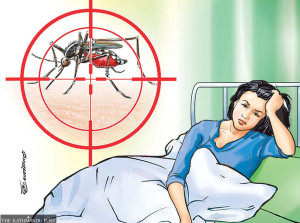Health
Japanese encephalitis spreads, but Nepal has no vaccine
Three people have died and 33 others have been infected from the virus that has spread to 18 districts.
Arjun Paudel
The number of cases of Japanese encephalitis (JE) infection has reached 33, up from 13 some 10 days ago. Along with the new cases, the number of deaths and districts reporting outbreaks of the deadly virus have also risen—three deaths and 18 districts.
Health ministry’s data show the case fatality rate among infected people is over nine percent, and the rise in the spread of the infection clearly indicates that the country is again witnessing a resurgence of the deadly disease, which has killed and infected thousands of people in the past. The unvaccinated make up most of those infected and dead.
Experts warn that without vaccination, these vulnerable populations are at high risk, and the government has yet to take decisive action to contain the outbreak.
“Vaccination is a proven and effective method to contain the spread of the JE virus,” said Dr Yasho Vardhan Pradhan, former director general at the Department of Health Services. “As the country has again witnessed a resurgence of the JE outbreak, vaccination is the only way to save lives and prevent permanent neurologic, cognitive and behavioural sequelae.”
JE is a viral brain infection endemic to Asia and parts of the Western Pacific. According to the World Health Organisation, it is a mosquito-borne flavivirus belonging to the same family as dengue, Zika, yellow fever, and West Nile viruses. The virus kills a third of those who fall ill and leaves up to half of the survivors with severe lifelong disabilities, according to the UN health body.
Last year, 23 people succumbed to the disease, including one in the Kathmandu Valley, and over 80 people were infected. Doctors say the actual number of cases could be much higher, as tests were carried out only on hospitalised patients with severe symptoms.
This year, Morang, Bara, Jhapa, Saptari, Siraha, Sarlahi, Parsa, Nawalparasi West, Sindhuli, Bardia, and Chitwan districts have reported JE cases. Five provinces—Koshi, Madhesh, Bagmati, Gandaki and Lumbini have reported JE infection.
Data show that mortality rate among people above 15 years of age is higher compared to those below 15, which indicates that those not receiving JE vaccine are at high risk of infection.
Experts say the unvaccinated population is at high risk of deaths and complications of JE infection. However, health authorities do not have immediate plans to vaccinate the unvaccinated population.
“We have capacity and human resources, but we currently don’t have the vaccine,” said Dr Abhiyan Gautam, chief of the Immunisation Section at the Family Welfare Division under the Department of Health Services. “We don’t have a budget to buy the vaccine. We have also requested our development partners, but there is no response.”
Gautam said various preventive measures, including awareness drives, environment management for vector control, and case management training for doctors in health facilities, have been taken in disease-hit districts. However, the rise in the number of infections in Tarai districts shows that those measures are not very effective.
Health Ministry officials admit that JE is the number one killer among vector-borne diseases, and vaccination could help control the spread of infections. They said that their attempts to convince development partners, including the World Health Organisation, to support a mass JE vaccination campaign have not succeeded over the past year.
“Despite knowing how dangerous the JE virus is, we are not able to do much to administer a vaccine to the unvaccinated population,” said Dr Bibek Kumar Lal, director at the Family Welfare Division, under the Department of Health Services. “We held multiple rounds of meetings with development partners and requested help for the vaccine, but could not convince them.”
In 2005, JE killed nearly 2,000 people in Nepal—mostly children from Tarai districts. Nepal started administering the JE vaccine in 2006, eight years before the World Health Organisation officially issued prequalification certification, due to the high rates of infection and deaths from the virus at the time.
In the first phase, all populations of the highly affected four districts—Banke, Bardiya, Dang, and Kailali—reveived the JE vaccine. Later, the vaccination programme was expanded to 19 other affected districts, and children under 15 were inoculated.
The government integrated the JE vaccine into routine immunisation in 2015. Still, people continue to die and dozens get infected by the deadly virus every year.
Public health experts say this is the right time to vaccinate all those at risk. Even if the vaccine does not help in outbreak management, it provides immunity against future infections, according to them.
“Every year, the Health Ministry could spend only around 60 percent of the allocated budget, so budget should not be an issue to save the lives of the population,” said Pradhan, who is also an immunisation expert. “Along with vaccination, authorities must take other measures to prevent further spread of the deadly disease.”
Doctors say complications from JE infection can cause permanent injuries to the brain and the nervous system. The disease has no cure, so treatment focuses on managing symptoms. However, safe and effective vaccines have been developed to prevent infection.
The JE virus is transmitted to humans through the bite of infected Culex mosquitoes. Pigs and ducks are considered natural reservoirs of the virus.
Doctors advise avoiding mosquito bites, such as by using mosquito repellents, wearing long-sleeved clothes, and getting vaccinated if one lives in or travels to disease-endemic areas. They also stress the importance of awareness and timely treatment to prevent infections and deaths.
An estimated 12.5 million people are thought to be at high risk of JE infection in Nepal.




 10.12°C Kathmandu
10.12°C Kathmandu














